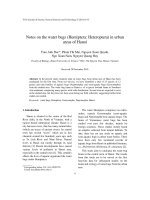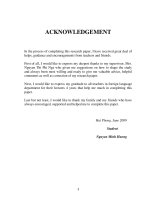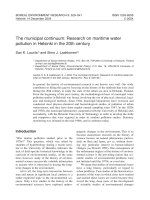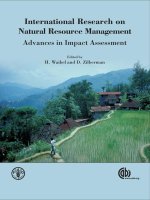eutrophication on natural water
Bạn đang xem bản rút gọn của tài liệu. Xem và tải ngay bản đầy đủ của tài liệu tại đây (218.68 KB, 16 trang )
VNU University Of Science - 334 Nguyen Trai –Thanh Xuan – Hanoi Faculty of EnvironmentEnvironmental Technology
Environmental Chemistry
REPORT
Eutrophication on natural water
Group 6
Students: Dang Minh Son, Cu Thi Hien, Le Nam Thanh, Nguyen Ngoc Khanh, Phan
Lam Tung, andNguyen Quang Van
Class:K55 TT KHMT, Faculty of Environmental Science, VNU University of Science
Instructor: Assoc. Prof Nguyen Thi Ha
Hanoi, 14thMay 2013
Abstract
1
Eutrophication in natural water systems
The paper is about eutrophication on natural water systems. Eutrophication is water
pollution as the result of the excess of one or more nutrient(s) in a water-body.
Eutrophication promote excessive plants growth leading to many effects on water quality
such as increased biomass of phytoplankton, increases in blooms of gelatinous zooplankton,
decreases in water transparency (increased turbidity), color, smell, and water treatment
problems, dissolved oxygen depletion, loss of desirable fish species…Eutrophication can be
human-caused or natural. Untreated sewage effluent and agricultural run-off carrying
fertilizers are examples of human-caused eutrophication. However, it also occurs naturally
in situations where nutrients accumulate (e.g. depositional environments), or where they
flow into systems on an ephemeral basis. Nitrogen is one of two main agents that causes
almost eutrophication. Nitrogen pollution has increased remarkably over the past several
decades as a result of increased creation of reactive N for fertilizer use and, inadvertently,
from combustion of fossil fuels. The paper makes clear of the sources where nitrogen (N)
came from; its transformation, transportation and conversion processes in the system; the
impacts of eutrophication on systems.
1.
purposes. One of the most dominant
Introduction
During
the
last
four
decades,
eutrophication has undoubtedly been the
most challenging threat to the quality of
our freshwater resources. Survey of the
International
Lake
Environmental
Committee has indicated in the early
1990s that some 40-50% of lakes and
reservoirs are eutrophicated. Many of
these
water
bodies
are
extremely
important for drinking water supply,
substances
causing
Nitrogen
(N2).
recognition
eutrophication
Therefore,
of
is
early
eutrophication,
understanding all processes relating to
transformation of nitrogen in natural water
during occurring eutrophication processes
and impacts of it are so important to
manage and minimize nutrient enrichment
in almost water bodies. This paper will
give more knowledge for eutrophication in
recreation, fishery, and other economic
2
Eutrophication in natural water systems
natural water, especially nitrogen that
cause this phenomenon.
2.
ensue, promoting growth of bacteria such
Definition of eutrophication
In the most basic terms, eutrophication is
nutrient pollution. When an ecosystem
experiences an increase in nutrients,
primary producers reap the benefits first.
In aquatic ecosystems, species such as
algae experience a population increase
(called an algal bloom). Algal blooms
limit the sunlight available to bottomdwelling organisms and cause wide
swings in the amount of dissolved oxygen
in the water. Oxygen is required by all
aerobically respiring plants and animals
and it is replenished in daylight by
photosynthesizing plants and algae. Under
eutrophic conditions, dissolved oxygen
greatly increases during the day, but is
greatly reduced after dark by the respiring
algae and by microorganisms that feed on
the increasing mass of dead algae. When
dissolved
oxygen
levels
decline
to
as Clostridium botulinum that produces
toxins deadly to birds and mammals.
Zones where this occurs are known as
dead zones.
3. Sources
Eutrophication can be human-caused or
natural. Untreated sewage effluent and
agricultural run-off carrying fertilizers are
examples
of
human-caused
eutrophication. However, it also occurs
naturally in situations where nutrients
accumulate
(e.g.
depositional
environments), or where they flow into
systems
on
an
ephemeral
Eutrophication
generally
excessive
growth
plant
basis.
promotes
and
decay,
favoring simple algae and plankton over
other more complicated plants, and causes
a severe reduction in water quality.
hypoxic levels, fish and other marine
Eutrophication was recognized as a water
animals suffocate. As a result, creatures
pollution problem in European and North
such as fish, shrimp, and especially
American lakes and reservoirs in the mid-
immobile bottom dwellers die off. In
20th century. Since then, it has become
extreme
more widespread. Surveys showed that
cases,
anaerobic
conditions
3
Eutrophication in natural water systems
54% of lakes in Asia are eutrophic; in
fertilizer and livestock manure to provide
Europe, 53%; in North America, 48%; in
and
South America, 41%; and in Africa, 28%
crops.Mineral fertilizers are the major
[1]. Many ecological effects can arise
source of nitrogen input in agriculture.
from stimulating primary production, but
However, we cannot know exactly the
there are three particularly troubling
amount of nitrogen which crops need and
ecological
impacts:
decreased
we use fertilizer based on estimation. So,
biodiversity,
changes
species
it is easy to make excessive nitrogen.
in
supplement
Nitrogen
for
composition and dominance, and toxicity
Nitrogen
effects.
particularly soluble to facilitate uptake by
For
further
understanding
about
eutrophication, let us consider one case of
eutrophication which is cause by the
excess of nitrogen in the system.
in commercial fertilizer is
crops. Nitrogen which is not taken up by
plants may be metabolized by microorganisms in the soil to improve soil
fertility. This is a slow process however,
and the major risk is that nutrients,
Nitrogen is one of two main agents (the
particularly nitrate which is very soluble,
other is Phosphorus) that causes almost
will run off into surface water or percolate
eutrophication
ecosystems
(N
and
P
for
saltwater
into groundwater. Livestock manure is the
for
freshwater
second most important source of nutrient
has
inputs to agricultural land. Not all the
increased remarkably over the past several
nitrogen contained in excreted manure is
decades as a result of increased creation of
spread on the land. A certain amount is
reactive
and,
lost through volatilization of ammonia
inadvertently, from combustion of fossil
from stables and during storage. This
fuels [2]. There are many sources where N
ammonia is a contributor to acidification.
can come from including the following
Acid rain Concentration of nitrogen
five sources [3] [4].
dioxide in the air rises more and more
AgricultureNitrogen is essential for crop
because
growth and human usually use mineral
deforestation, transportation, agricultural
ecosystems).
N
Nitrogen
for
pollution
fertilizer
use
of
burning
fossil
fuel,
and industrial activities. It combines with
4
Eutrophication in natural water systems
water vapor to create nitric acid which
Chemical forms of nitrogen are most often
soluble into the rain water to make acid
of concern with regard to eutrophication,
rain. It is also cause the rise in nitrogen
because
concentration in natural water.
requirements so that additions of nitrogen
Wastewater Untreated wastewater and
wastewater
treated
by
mechanical-
biological methods contain about 32mg/L
nitrogen. So, waste water is a source of
nitrogen
which
causes
of
nitrogen
eutrophication in natural water.
plants
have
high
nitrogen
compounds will stimulate plant growth.
Nitrogen is not readily available in soil
because N2, a gaseous form of nitrogen, is
very stable and unavailable directly to
higher plants. Terrestrial ecosystems rely
on microbial nitrogen fixation to convert
N2 into other forms such as nitrates.
Aquaculture In aquaculture, excess fish
However, there is a limit to how much
food pollutes the water as complete use of
nitrogen can be utilized. Ecosystems
the food cannot be achieved. Nitrogen
receiving more nitrogen than the plants
present in the excess food is dissolved or
require
suspended in the water. This process also
Saturated terrestrial ecosystems then can
effect to the amount of nitrogen in natural
contribute both inorganic and organic
water.
nitrogen to freshwater, coastal, and marine
The sediment of water bodies like rivers,
eutrophication, where nitrogen is also
lakes, marshes -its muddy bottom layer
typically
-contains relatively high concentrations of
following
nitrogen. These can be released to water,
transformation of nitrogen in the system.
are
called
a
nitrogen-saturated.
limiting
part
nutrient.
shows
fate
The
and
particularly under conditions of low
oxygen concentrations. The nutrients in
State
the sediment come from the past settling
Nitrogen in water can take several forms.
of algae and dead organic matter.
The dominant combined N species in
water are: dissolved inorganic N:NH 4+,
4.
State and transformation
NO3-,
NO2-;
dissolved
organic
N;
particulate N, which is usually organic but
can contain inorganic N.
5
Eutrophication in natural water systems
Transformation
In
normal
its bioplasm by sunlight energy and
condition,
transformation
inorganic
substances
through
process depending on water properties,
photosynthesis—the
process
of
various inorganic nitrogen compounds
eutrophication is described as follows:
may be found. In aerobic waters nitrogen
is mainly present as N2 and NO3- and
depending on environmental conditions it
According to above equation, it can be
may also occur as N2O, NH3, NH4+, HNO2,
concluded that inorganic nitrogen and
NO2- or HNO3.
phosphorus are the major control factors
Nitrification and de-nitrification processes
carried out by various microorganisms.
Nitrification means ammonium oxidation
from protein decomposition processes by
bacteria, and subsequent conversion to
nitrates. This requires oxygen, which is
added by aeration. The water must be
aerated for a sufficient period of time.
Ammonium is converted to nitrite, and
subsequently to nitrate. The reaction
mechanism is a follows:
for the propagation of algae, especially
phosphorus. Generally, the physical and
chemical evaluation parameters were used
to assess water eutrophication, mainly
nutrient concentration (N and P), algal
chlorophyll,
water
transparency
and
dissolved oxygen. The eutrophication or
red tide occurs when N concentration in
water
reaches
concentration
300
reaches
μg/L
and
20
P
μg/L.
Richardson et al. (2007) reported that
exceeding a surface water mean TP
threshold concentration of 15 μg/L causes
During
the
de-nitrification
bacteria
an ecological imbalance in algal, macro-
decompose nitrates to nitrogen. This does
phyte and macro-invertebrate assemblages
not require aeration, as it is an anaerobic
as well as slough community structure in
process. Nitrogen is eventually released
the Everglades areas [6].
into air [5].
In
excess
nutrient
contents,
water
eutrophication is caused by the autotrophy
algae blooming in water, which composes
To further understand the fate of nitrogen
in the system and how it transform, let us
take the look deeper in the process.
6
Eutrophication in natural water systems
Nitrogen cycling generally has 5 reactions
Assimilation,
as shown in the following figure: Fixation,
Ammonification, and Denitrifilication [7].
Nitrogen
bacterially
demonstrate in Belham Tarm in English
mediated, exergonic reduction process
Lake District. The author founded that
which convert molecular N to ammona:
added N-enriched sodium nitrate was
fixation
is
a
Nitrification,
removed from water within 14days. The
added
In
general,
N
fixation
adenosine
N
accumulated
in
resulting
Microcytis bloom. These result suggested
triphosphate (ATP) which is generated by
that
photosynthesis,
is
producers maybe important mechanism
However
for removal of nitrate, although this
Anabeana,
depends on the ultimate fate of nitrogen
Aphanizomenon, Gloeotrichia) can fix
once it reach the sediment because of N
nitrogen directly.
maybe available for re-release.
Assimilation of nitrogenThe importance
Ammonification Ammonium production
of plankton assimilation of nitrate was
occur both in the water column of rivers
inefficient
so
at
cyanobacteria
this
night.
(primary
process
Nitrogen
stripping
by
primary
7
Eutrophication in natural water systems
and lakes and their sediment. Microbial
nitrite is rarely present in appreciable
decomposition convert organic nitrogen to
concentration in fresh water. Nitrate, the
ammonia trial form. This process is
end product is highly oxidized, soluble
oxygen-demanding
regenerates
and biologically available.Nitrification is
available nitrogen for re-assimilation by
oxygen demanding and can, in some
primary producer. Ammonification can
aquatic systems, create anoxic conditions.
result rapid in nitrogen cycling between
This is because of Nitrosomonas and
the sediment and the water column.
nitrobacter are strict aerobes, requiring
Ammonia can exist as the ammonium
minimum oxygen concentration around
cation (NH4+) or as the un-ionied ammonia
2mg/l to function efficiently.
and
molecule (NH3). High temperature and
high pH encourage the conversion of
ammonium
to
ammonia.
High
concentration of ammonia areusually only
associated with wastewater discharge
where biological treatment is minimum.
Denitrification Loss of nitrate can occur
through denitrification or dissimilatory
nitrate
reduction.
Denitrification
is
quantitative more important, particularly
in lake sediment and is high in summer
month.
The
rate
and
extent
of
Nitrification is a two stage oxidation
denitrification is controlled by the oxygen
process mediated be chemoautotrophic
supply and available energy provided by
general
organic matter. It is seen as an important
Nitrosomas (NH3 to NO2-) and nitrobacter
(NO2- to NO3-). The net reaction
mechanism in the reduction of nitrate
concentration in reservoirs, but it is
limited be the requirement for anaerobic
condition and fixed bacterial carbon
The oxidation of ammonia to nitrite by
supply.
nitrosomonas is usually rate-limiting, so
8
Eutrophication in natural water systems
Table 1: FACTORS RELATE TO EACH PROCESS OF NITROGEN
Process
Nitrogen fixation
Mineralization
Nitrification
Denitrification
Assimilation
Factor
Cyanobacteria at lake surface
Photosynthesis bacteria at anoxic zone
N fixation when soluble N concentration is low
More important in lake sediment
Rapid mineralization when plankton biomass dominate lake
Autotrophic in NH4+ and O2 dependent
Seasonal,
affected
by
NO3-supply
general occur in sediment-water interface
Phytoplankton,
varies
with
NO3concentration
+
NH4 can be assimilated if available
As mention in the previous part of the paper, many ecological effects can arise from
stimulating primary production including the decreased biodiversity, changes in species
composition and dominance, and toxicity effects. Rather than impacts of nitrogen
eutrophication, the below effects will give the whole picture of eutrophication in general to
ecosystem [8].
5.
Effects of eutrophication
Effect on water chemistry
Dissolved Oxygen (DO) Nutrient enrichment leads to excessive growth of primary
9
Eutrophication in natural water systems
producers as well as heterotrophic bacteria and fungi, which increases the metabolic
activities
of natural water and may lead to a depletion of dissolved oxygen (Mallin et al. 2006).
During the day, photosynthesis by primary producers provides a large amount of oxygen to
the water. At night, photosynthesis stops and elevated respiration by algae and bacteria
continues to consume dissolved oxygen, which can deplete DO. Furthermore, as primary
producers die, they are decomposed by bacteria that consume oxygen. Large populations of
decomposers consume more dissolved oxygen, which increases the severity of DO
depletion. For example, daily oxygen fluctuations in enriched streams at low flow were
reported to range from a high of approximately 25 mg/L at noon to a low of approximately
3 mg/L at night (Wong and Clark 1976).
pH During photosynthesis, carbon dioxide (CO2) and water are converted by sunlight into
oxygen and carbohydrate. Hydroxyl ions (OH-) are produced, raising the water column pH.
In addition, plants use a large amount of dissolved CO2 for photosynthesis, resulting in
lower levels of carbonic acid (H2CO3) in the water column. Thus, photosynthesis increases
water column pH. At night, increased respiration from biota increases the release of CO2
into the water, increasing the production of carbonic acid and hydroxyl ions, which, in turn,
increases the acidity.
Other chemicals Toxic effects of chemicals released from certain cyanobacteria have been
reported in lakes; very few studies have found cyanotoxins in streams. Pfiesteria, a toxic
substance produced by dinoflagellates that cause fish kills, has also been reported in coastal
rivers associated with nutrient enrichment (Burkholder 1999). A relatively new golden alga,
Prymnesium parvum, has been reported to be toxic in Texas. The toxin prymnesin affects
gill-breathing organisms including fish, tadpoles, and clams (Rhodes and Hubbs 1992) and
has been responsible for an estimated 2.5 million dead fish and millions of dead clams in the
Pecos, the Colorado, and Brazos river basins in Texas.
10
Eutrophication in natural water systems
Other chemicals can taint drinking water supplies and recreational waters. 2methylisoborneol and geosmin are two chemicals produced by cyanobacteria that can cause
taste and odor problems in drinking water. Livestock that drink water contaminated with
cyanobacteria have died (Dodds and Welch 2000). Humans who drink or swim in water that
contains high concentrations of toxins from cyanobacteria may experience gastroenteritis,
skin irritation, allergic responses, or liver damage (CDC 2004).
Direct biological responses of streams to eutrophication: primary producers
Responses of algal biomass to nutrient enrichment A number of authors have
documented the positive relationship between benthic algal biomass and nutrient
concentrations (see reviews by ENSR 2001, Virginia WRRC 2006, Dodds 2002, 2006).
These studies established that total N and total P in the water column are significantly
related to benthic algal biomass that the more nutrient enrichment is, the more algal biomass
has.
Responses of algal species composition to nutrient enrichment Algal species
composition changes with elevated nutrient concentrations (Stevenson 1996, Pan et al.
1996, Stevenson and Smol 2001). Because of their small scale, periphytic algae composition
receives less public attention, while problematic macroalgae (e.g., Cladophora) and
cyanobacteria receive more. Under most circumstances, a diatom dominated algal
community represents healthy, non-enriched stream water quality, while a predominance of
filamentous algae may indicate problems with nutrient enrichment. Since algae are often
the problem associated with enrichment, a change of taxonomic composition in a stream can
show whether nuisance algae are present and can indicate long or short-term changes in
point and nonpoint source pollution (Lowe and Pan 1996) that cannot be detected by a onetime sampling of water chemistry. Thus, algal species composition could be considered an
important indicator of nutrient pollution.
Responses of macrophytes to nutrient enrichment Nutrient effects on macrophytes are
poorly studied (Chambers et al. 1999). However, nutrient supply can affect plant attributes.
Nutrient enrichment in streams and rivers leads to increasing plant biomass (Chambers and
11
Eutrophication in natural water systems
Prepas 1994, Gucker et al. 2006), declines in plant richness (Thiebaut and Muller 1998,
San- Jensen et al. 2000). For example, reduction of nutrient (particularly N) input from
municipal wastewater sources led to macrophyte biomass declines in the Bow River
(Alberta) (Sosiak 2002).
Indirect biological responses of streams to eutrophication: microbial cycling
The organisms are important components of water food webs and play a key role in carbon
cycling.
Bacteria -Similar to algae, bacteria are also limited by nutrients in aquatic systems,
especially in planktonic forms (Cole 1982). Bacteria can outcompete algae for nutrients
because of their higher surface area to volume ratio. - Bacteria can either inhibit algae by
outcompeting it when nutrients are limited, or they may interact positively with algae by
using its photosynthetic products and decomposing dead plant and algal biomass and
recycling nutrients. - Nutrient enrichment tends to increase both algal and bacteria biomass
(Carr et al. 2005). Sobczak (1996) found that interactions between bacteria and algae are
weakened in the presence of a labile source of allochthonous DOC, under extreme light
limitation, or under extremely oligotrophic conditions where algae are severely nutrient
limited.
Fungi Similar to bacteria, fungi also play an important role in detrital decomposition in
water. Fungal communities in many water bodies are also limited by nutrients (Grattan and
Suberkropp 2001, Tank and Dodds 2003). This limitation can be released by nutrient
additions that lead to significantly higher fungal biomass. Bacteria and fungi also compete
with each other for nutrients (Gulis and Suberkropp 2003b). Gulis and Suberkropp (2003b)
found that fungi inhibit bacterial growth and reduce bacterial biomass by 2-fold at low
nutrient concentrations, suggesting that nutrient availability may modify microbial
interactions. Fungi seem to be a superior competitor than bacteria on leaves. Fungal biomass
can be one or two order of magnitudes higher than bacterial biomass in polluted water.
12
Eutrophication in natural water systems
Indirect biological responses to eutrophication: herbivores
Nutrient enrichment accelerates autotrophic production and algal biomass in water, and
consequently changes ecosystem structure at other trophic levels.
Invertebrates - Changes in macroinvertebrate composition with nutrient enrichment are
more complicated than changes of abundance. Mayflies, a group of invertebrates that are
considered sensitive to environmental pollutants, show highest relative abundance when
algal biomass is at intermediate levels (Miltner and Rankin 1998). The abundance of
scrapers, a functional group that is closely related to grazers, is highest when nutrient levels
are elevated, indicating positive effects from increased algal availability. Similarly, scrapers
and detritivores (e.g., Oligochaeta, Lumbriculidae) have shown significant increases in
density or biomass on certain substrata with enrichment even while total macroinvertebrate
density or biomass did not (Sabater et al. 2005). - Enrichment may also alter benthic habitat
for macroinvertebrates. In addition to food sources for invertebrates, benthic algae,
especially macroalgae, are important habitat for macroinvertebrates. Some algal species or
growth forms are grazer- resistant (e.g., Oedogonium spp.) and are good habitat for many
invertebrates.
Fish - Fish may benefit from increases in food availability when nutrient additions increase
primary and secondary production. Enrichment of oligotrophic streams and rivers may
result in increased algal biomass, increased benthic invertebrates, and fishes. - One of the
consequences of nutrient enrichment may be loss of sensitive fish taxa and increases in
tolerant taxa. The strong correlation between fish metrics and nutrient pollution indicates
that nutrient enrichment has contributed to changes in the structure of fish assemblages.
While nutrient enrichment could potentially benefit fish production in the short term, the
ecological consequence of nutrient addition could have severe impacts on water ecosystems
(Stockner et al. 2000). In addition, excess algal growth would eliminate important feeding
and respiration habitat, further reducing survivorship. While it is evident that some nutrient
subsidy benefits the growth of select species, the overall impact is negative, especially at
stressful nutrient levels.
13
Eutrophication in natural water systems
Effect on food web structure
As we know that each trophic level is controlled by both predators (top-down control) and
resources (bottom-up control). Changes at one trophic level would alter material cycling and
other trophic levels in the food web (trophic cascading). Long-term fertilization studies have
demonstrated the cascading effect of nutrient enrichment at several trophic levels.
Huntsman (1948) first recognized that fertilizers stimulate downstream algal growth, and
lead to increased insect and fish densities. Since then, more quantitative studies (Peterson et
al. 1993, Slaney and Ashley 1998) have shown that nutrient additions increase algal
biomass at least at the beginning of the enrichment. Later, top-down forces take effect to
control primary consumers and consequently algal biomass. Generally, grazing has
demonstrated a larger effect than resource limitation in influencing algal biomass and
composition (Steiman 1996, Lamberti 1996, Flecker et al. 2002).
While nutrient additions affect higher trophic levels, predators also play an important role in
influencing nutrient demand and nutrient supply. Nutrient limitation in the presence and
absence of fishes and the response to nitrogen enrichment is significantly greater on
substrates accessible to natural fish assemblages compared to substrates where grazing
fishes are excluded. Many experiments demonstrate simultaneous and interactive effects of
top- down and bottom-up factors in limiting primary producers in water.
6. Conclusion
Today there is a scientific consensus, which has emerged from research at several spatial
and temporal scales that N represents the largest pollution problem in coastal waters and one
of the greatest threats to the ecological functioning of these ecosystems (Nixon 1995;
Howarth et al. 2000b; NRC 2000) [2]. Along with this is the widespread of eutrophication
in many water systems leading to water pollution in many regions. Human activities can
accelerate the rate at which nutrients enter ecosystems. Runoff from agriculture and
development, pollution from septic systems and sewers, and other human-related activities
increase the flow of both inorganic nutrients and organic substances into ecosystems.
14
Eutrophication in natural water systems
Eutrophication poses a problem not only to ecosystems, but to humans as well. Reducing
eutrophication should be a key concern when considering future policy, and a sustainable
solution for everyone, including farmers and ranchers, seems feasible. While eutrophication
does pose problems, humans should be aware that natural runoff (which causes algal blooms
in the wild) is common in ecosystems and should thus not reverse nutrient concentrations
beyond normal levels. Cleanup measures have been mostly, but not completely, successful
but still, some targeted point sources did not show a decrease in runoff despite reduction
efforts. The knowledge given by this paper will provide basic information about
eutrophication relate to nitrogen, in order to find solutions to treat, manage, minimize this
polluted phenomenon. Because this paper just focus on the sources, fate, transformation,
and impacts of Nitrogen in eutrophication , if needing more information relating to
eutrophication, the following references will provide for more understanding.
References
[1]
Lake Biwa Research Institute, "Survey of the State of the World's Lakes," Lake
Biwa Research Institute, 1993.
[2]
Robert W. Howarth and Roxanne Marino, "Nitrogen as the limiting nutrient for
eutrophication in coastal marine ecosystems: Evolving views over three decades,"
American Society of Limnology and Oceanography, Inc, 2006.
[3]
Donald M. Anderson, Patricia M. Glibert, Joann M. , "Harmful algal blooms and
eutrophication: Nutrient sources, composition, and consequences," Estuaries, vol.
25, no. 4, pp. 704-726, 2002.
[4]
"Division of Technology, Industry and Economics," United Nations Environment
Programme
UNEP,
14
May
2013.
[Online].
Available:
/>[5]
Xiao-e YANG, Xiang WU, Hu-lin HAO, Zhen-li HE, "Mechanisms and assessment
15
Eutrophication in natural water systems
of water eutrophication," Journal of Zhejiang University Science B, vol. 3, no. 9,
pp. 197-209, 2008.
[6]
David W. Bressler and Michael J. Paul, PhD, "Effect of eutrophication on wetland
ecosystems," Tetra Tech, Inc.
[7]
A. Heathwaite, "Nitrogen cycling in surface waters and lakes," in Nitrogen cycle
Surface water, 1993.
[8]
Lei Zheng, PhD and Michael J. Paul, PhD, "Effects of eutrophication on stream
ecosystems," Tetra Tech, Inc.
16









